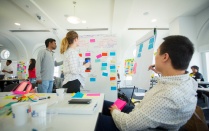How Dr. Shamim Islam is Working to Halt the Spread of Global Antimicrobial Resistance

Shamim Islam (center) with UB colleagues Jared Aldstadt (Geography) and Diana Aga (Chemistry), Dhaka, Bangladesh
By Jessica SCATES
Published October 16, 2019 This content is archived.
By 2030 antimicrobial resistance (AMR) could force 24 million people into extreme poverty; by 2050, up to 10 million deaths each year may be attributable to antimicrobial resistant infections.
Antibiotics, or antimicrobial therapies, one of the greatest achievements of modern medicine, has saved the lives of hundreds of millions if not billions of people around the world. However, overuse of antibiotics has resulted in evolving, drug-resistant bacteria, which have rendered common diseases very difficult to treat. These “superbugs” are without border or bias; they can infect anyone: rich or poor, old or young, male or female.
Dr. Shamim Islam, Clinical Associate Professor in the Department of Pediatrics, has invested his career to understanding and treating infectious diseases. As Medical Director for a recently established antimicrobial stewardship program at Oishei Children’s Hospital, Islam is focused on judicious antibiotic use. Islam’s team surveils the use of antibiotics among patients and suggests alternative antimicrobial agents based on literature and national guidelines. He also trains learners of various levels in the principles of appropriate and optimal antibiotic use.
Always fascinated by human physiology, microbiology and the science of infectious diseases, Islam sought a career in medicine where he could interact with and benefit humanity. Receiving his MD from Cornell, Islam completed his residency at UC San Francisco and fellowship in pediatric infectious disease at Children’s Hospital in Oakland, CA before coming to the University at Buffalo in 2015.
Islam’s interest in infectious disease has taken him around the world. Throughout his formal training programs, Islam eagerly took advantage of long-term public health research opportunities, working at Dana Farber Cancer Institute exploring the structure of the HIV virus, studying arsenic exposure among villagers in Bangladesh, as well as completing trainings in tropical medicine in Peru and London, and investigating Leishmaniasis in Bangladesh.
Increasing the Urgency for AMR Research
We “consume” our environment in the food we eat, but also the air we breathe, the ground we step on, and the products we use. Although the overuse of antibiotics can result in direct AMR, we must also be aware of the secondary effects of antibiotic use. Wastewater from our hospitals, farms, commercial facilities, and homes discharged into rivers, streams, and the earth results in AMR among individuals who have not directly consumed antibiotics. Our every interaction with the environment and the people around us can result in exposure to antibiotic resistant bugs.
Today’s scientific literature lacks studies that investigate the interaction between environmental exposures and AMR. Standards on what level of antibiotic residue, or antibiotic bacteria and genes, that may be considered safe in the environment, are lacking; blood lead levels exist to reduce the potential for lead poisoning yet similar guidelines on AMR exposures are yet to be developed. With the Community for Global Health Equity, Islam leads a project that seeks to explore and establish more clearly the myriad of ways that human beings are exposed to antibiotic resistant pathogens in the environment with the intent to bring more attention and oversight to AMR around the world. Islam’s team is working in Bangladesh where AMR to multiple drugs is common. With the icddr,b, one of the world’s leading global health research institutes, they are testing wastewater discharges from health facilities to understand how antimicrobials in water contribute to AMR throughout the population. Preliminary results demonstrate that natural water sources, including ponds and tubewells used for washing and drinking, are frequently contaminated with antibiotics, anti-fungals, and other chemicals. Also, the majority of residents appear to have intestinal colonization of bacteria with concerning drug-resistance mechanisms, including against antibiotics of last resort, the carbapenems and colistin.
At UB, Islam’s team seeks to increase research, education, and outreach around the danger of AMR. In 2015, Islam’s team held an international AMR workshop at UB to advance research around the drivers and transmission dynamics of AMR. His recent co-authorship of a chapter in Transforming Global Health: Interdisciplinary Challenges, Perspectives, and Strategies (Springer, January 2020) seeks to widen the conversation around global AMR in university classrooms. Moreover, here at UB, Islam foresees opportunities to include One Health trainings in the development of the new medical school curriculum.
Without science that contributes to AMR policies and guidelines, AMR is on a trajectory to be the major cause of death around the world. Academics and practitioners of public health, medicine, veterinary medicine, economics, and agriculture must come together and incorporate multi-disciplinary perspectives to best combat the pressing challenge that global AMR already poses. Shamim Islam, with other collaborators connected to UB’s CGHE, are leading such novel One Health scholastic and advocacy efforts on AMR.
